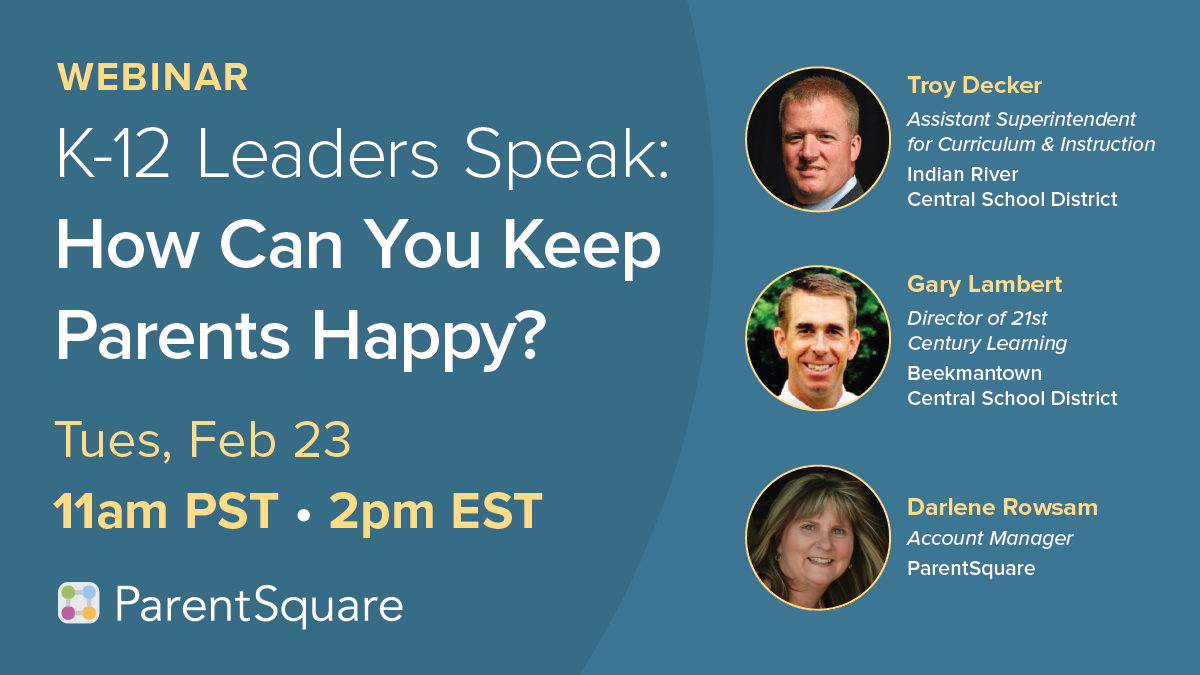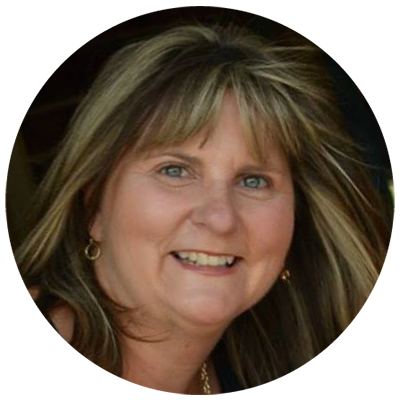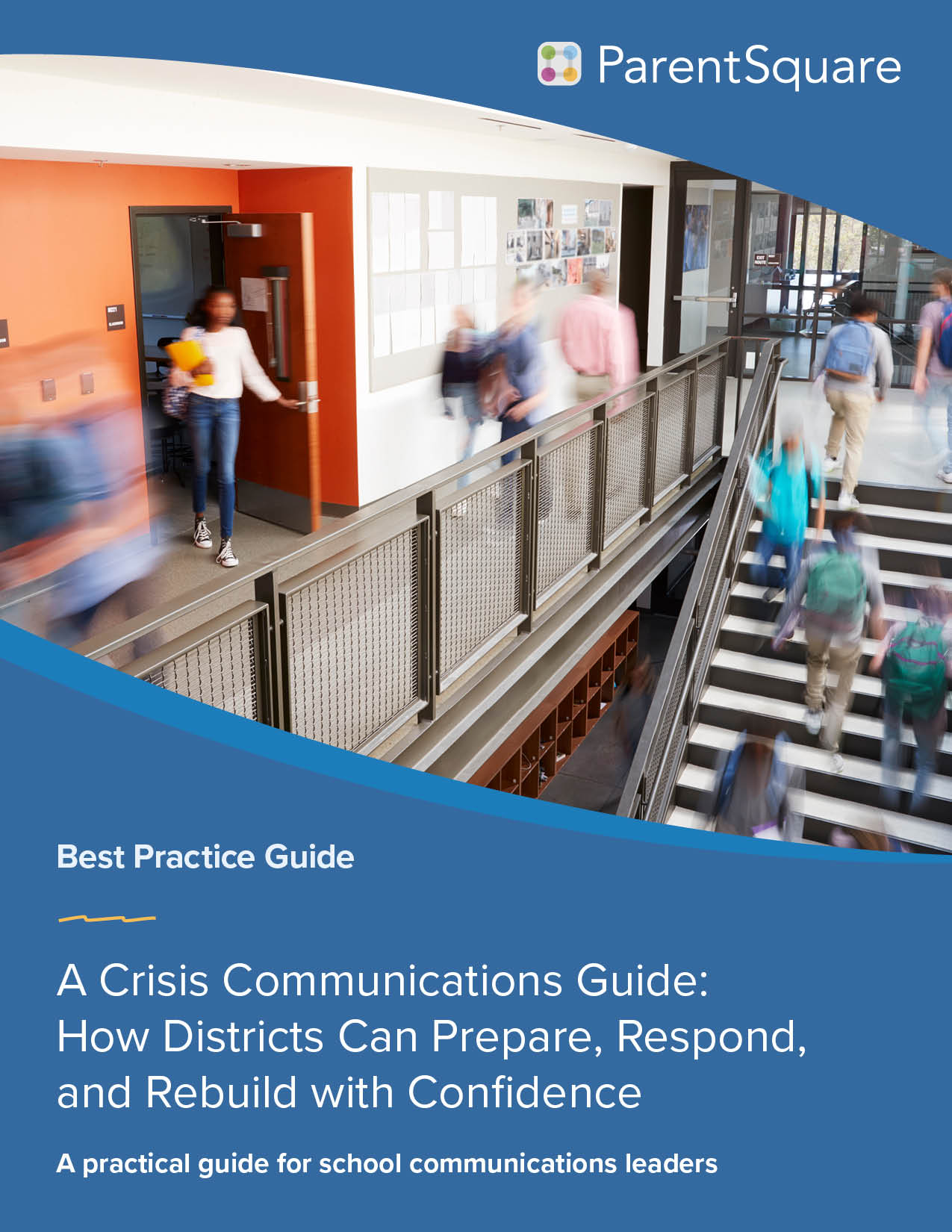
Meeting the needs of families is always a top priority of schools and districts. However, with changing learning scenarios and COVID-19-related challenges, keeping all parents happy has become a more significant challenge.
Recently, we sat down with two K-12 leaders and our very own ParentSquare Account Manager, Darlene Rowsam, to talk about tips for supporting families’ needs amid the pandemic.
Panelists shared their perspectives on how to use communications effectively to build relationships with parents, including how to meet the needs of parents with differing communications preferences and how to connect with the hardest-to-reach families. They also discussed the importance of following state-mandated communication privacy protocols and gave advice for implementing a secure school-home communications platform in your district.
Here are some key takeaways from their discussion during our “K-12 Leaders Speak: How Can You Keep Parents Happy?” webinar.
Q: Share with us the who, what, why, when, and how of school-home communications for you.
For Troy Decker, assistant superintendent for curriculum & instruction at Indian River Central School District, NY, fostering connections within the school community is at the heart of his district’s success. The primary way that he builds relationships is through solid communication. His goal is to reach out to families easily, and he wants to ensure that parents feel that they can do the same in return.

“Communication is such an important part of what we do. We’re all about building relationships, and to build a relationship, you gotta have connections. And those connections are not always easy to do, so we want to be able to reach out, and have parents also do the same and be able to connect with their staff, connect with their buildings, and connect with their districts.” —Troy Decker, Assistant Superintendent for Curriculum & Instruction, Indian River Central School District
Gary Lambert, the director of 21st century learning for Beekmantown Central School District, NY, echoed Troy’s thoughts, explaining that school-home communications are essential for building a trusting relationship with families. First of all, using strong communication about what you are doing helps keep false or negative information from spreading, which could jeopardize parents’ trust in you. Also, strong relationships with parents are essential because they are the ones who are reinforcing at home what you do in the classroom.
“In the absence of clear messaging, other messaging will seep in on its own, and then you lose control of the narrative. It’s important to identify those tools that can best suit your means of communicating with your school community so that it is a positive relationship and not an adversarial one.” —Gary Lambert, Director of 21st Century Learning, Beekmantown Central School District

Q: How have you dealt with the increased need for two-way school-home communications due to COVID-19 and remote learning?
With the increase in information that needs to be shared because of COVID-19 and shifting learning scenarios, robust communications plans have become even more essential, so all parents have the details they need on a daily basis.
Gary explained that his district increased two kinds of communications since the onset of the pandemic. First, they have had to increase their instructional-related communications because of shifting learning scenarios; and second, they have had to communicate information about COVID-19 that parents need to know.
To tackle the increase in comms needs, panelists focus on the consistency of their communications. Communications are sent out on the same schedule each week so that parents know when they will receive them and are not being overloaded with messages every day.
Panelists are also consistent in their communication styles. Parents know what communications will look like and what to expect from them. For example, Darlene Rowsam, Account Manager at ParentSquare and former technology specialist based out of New York, explained that a school in her district sent out a principal’s video message every day. Parents knew what the message would look like and when they would receive it, which helped make communications more manageable.
Additionally, Troy’s district frames communication around three levels: building, staff, and district. Focusing on three aspects of communications ensures that they share all necessary information with parents in an organized way.
Q: How are you communicating with your hardest-to-reach families?
Another critical aspect of a strong communications plan is ensuring that your communications are equitable. K-12 leaders need to utilize multiple modes of communication and update student contact information so all families can reliably receive school or district communications.
Gary noticed that one of the reasons why some families were unreachable was because of incorrect contact information. Each building was collecting information differently, which meant some information was incorrectly reported or lost in the process. To mitigate the confusion with contact information, they consolidated collecting student data to a central registrar. Now, one person manages all data entry. You can read more about it here!
Once correct contact information is achieved, you can focus on communicating with parents in their preferred modality. For example, parents may want to receive communications via a phone call, text, or push notification, while others prefer email, social media, or the school website. Allowing families multiple options of where to receive their communications helps ensure parents see important messages and engage.
When none of the communication modalities work, Troy gets creative! He visits students and their families in-person (safely) to establish a connection and speak with them about how they prefer to receive communications, which further promotes equity by ensuring that no family is left out of the school-home communications process.
Darlene also suggested thinking of creative ways to communicate with hard-to-reach families:

“Some families that are the hardest to reach are maybe those who didn’t have a great educational experience themselves. Sometimes opening that door with something as simple as a fun post or a good news story can really be critical with moving forward and building those positive relationships.”—Darlene Rowsam, Account Manager, ParentSquare
Q: How do you make sure your communications efforts comply with NY EdLaw 2-D?
Note: NY EdLaw 2-D is a privacy and security law for New York schools and districts that protects student Personally Identifiable Information (PII) and select PII for teachers and principals. Many other states have similar privacy laws regarding communications.
Troy explained that it’s essential to remember that K-12 leaders are responsible for upholding privacy standards regardless of privacy laws because a breach of data is a big problem.
“In addition to the privacy concerns and the technical aspects of the privacy concerns, it’s important that districts realize that we are stewards of our staff data and our student data. We have a responsibility there.” —Troy Decker, Assistant Superintendent for Curriculum & Instruction, Indian River Central School District.
To achieve privacy standards, Gary suggested partnering with a service provider who understands the importance of maintaining data privacy. For his district, they know that every platform they use, such as ParentSquare, upholds data integrity and is secure. Gary explained that if a provider does not understand the importance of data privacy or does not comply with your security expectations, don’t use them!
Both Troy and Gary also suggested finding one secure service that can meet your school or district’s needs. By using one platform, there are fewer opportunities for a data breach along the way. What’s more, it is also easier for parents, students, and staff, to manage their communications when they only have one tool to navigate.
Q: Is it possible to keep parents happy? What should you aim for?
Parents and schools have the same goals—they want their kids to be safe, happy, and learn. Troy suggests that strong communication is at the heart of achieving these goals.
A key reason why parents express concerns is that they are overloaded with too many messages and feel that their communications needs aren’t being met. They may also be confused about where they can find information because there are so many different sources!
An easy way to solve this problem is through using a platform that allows parents to choose how and when they want to receive communications. The panelists agreed that ParentSquare’s customizable notification settings made a world of difference in keeping parents happy with school-to-home communications.
“You need to deliver that message in whatever form works best for the recipient of the message. You can’t assume that the way you prefer is going to be the one that works best for them.”
—Gary Lambert, Director of 21st Century Learning, Beekmantown Central School District
Q: What tactics and strategies are working for you that other schools or districts might try?
Panelists agreed that implementing a unified school-home communications tool like ParentSquare has considerably improved their overall communications. Gary believes that, without his electronic partners, he would not have survived these challenging months amid the pandemic!
When implementing ParentSquare, Troy suggests starting slow so you can measure your communications and gauge feedback from parents, students, and staff.
Once parents, staff, and students are more comfortable with ParentSquare, Gary suggests getting creative. For example, he creates fictional classes in their Student Information System (SIS) for the school sports teams, with the coach as the teacher, so they can have access to ParentSquare as well (ParentSquare syncs nightly with Beekmantown’s SIS). Involving the coaches and getting them set up on ParentSquare helps keeps communications consistent for parents because all messaging comes from the same place.
Another creative way to utilize ParentSquare is that school nurses can create a customized group and send out targeted messages to people who have not submitted immunization records—just two of the many unique ways to ensure parents engage with communications but are not overloaded.
Q: How is ParentSquare working for you?
Darlene explained that ParentSquare helped one of her districts maintain success despite the many challenges raised by COVID-19.
“When COVID hit…without that tool at that time, I really can’t imagine where we would have been.”
—Darlene Rowsam, Account Manager, ParentSquare
Gary feels that he is more successful in his career than he ever has been due largely to ParentSquare. He feels supported by ParentSquare and appreciates that his relationship with ParentSquare is a partnership.
“I’ve probably done two or three dozen implementations in my career that are like ParentSquare. Of all the ones I’ve done, I’ve felt the most supported and successful with this one.”
—Gary Lambert, Director of 21st Century Learning, Beekmantown Central School District
Finally, Troy appreciates that ParentSquare has taken so many aspects of their communications and put them into one unified platform. He’s had better feedback from his school community with the implementation of ParentSquare than with any other tool.
“We feel more confident in how we’re telling our district story…we now can communicate in a reasonable fashion, in a way that parents are able to control. We can do it as much or as little as we need to, and we can include some pretty snazzy tech tools. At the same time, we can make it very simple and very static…we can tell our district story in a way that makes sense for our people and us.”
—Gary Lambert, Director of 21st Century Learning, Beekmantown Central School District
We thank Darlene, Troy, and Gary for their insights and perspectives! What additional tactics and strategies are working for your school-to-home communications? We’d love to know!

